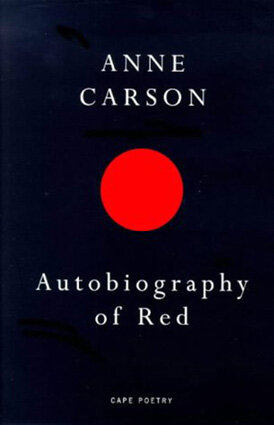I’ve been meaning to begin reading Anne Carson’s poetry for some time. Multiple people recommended I start with “Autobiography of Red” and I’m so glad I read this incredibly inventive book! Carson translated the existing fragments of a poem about a red winged monster with a human face named Geryon which was written by the Greek lyric poet Stesichorus’ who lived from 630-555 BC. In the opening sections Carson imaginatively discusses Stesichorus’ life and the legend of his being rendered blind for insulting Helen of Troy. Carson has said she found it difficult to satisfactorily translate his writing successfully so she’s taken the liberty of imaginatively filling out the story of Geryon’s life in this epic narrative poem which reads more like a novella. It takes elements from Geryon’s story but inserts them into a blend of the modern and mythic following his relationship with his mother, sexual abuse by his brother and his romantic entanglements with a man named Herakles (in the myth Heracles kills Geryon by shooting him with an arrow.) It’s stunning how she captures the sensations of Geryon’s life and his unique perspective: his feelings of alienation, artistic aspirations and sexual yearnings. And it’s so beautifully written with many complex lines and metaphors that made me pause and think.
Carson sympathetically portrays Geryon’s gradual awareness of his otherness as he gets older. There the obvious differences in how he appears as his body is red and he possesses wings which he learns to conceal. But he also perceives the world in a different way and at some points Carson describes his synaesthesia so that he can hear “noise that colors make. Roses came roaring across the garden at him.” So Geryon becomes aware that he’s an outsider who can never fully integrate with the people around him or have a traditional relationship with Herakles. He’s a part of society but outside of it and learns he can’t live without it: “There is no person without a world.” Yet there’s a tremendous wellspring of emotion within him which is symbolised by a pilgrimage he and Herakles take to a volcano. He also takes up photography as if becoming an observer and recorder can emotionally remove him from reality.
This is book filled with so many profound and beautifully-made observations I’m sure I’ll return to it again and again.








